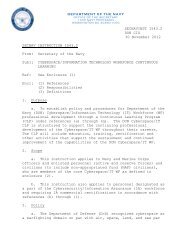HowToFormANonprofit_1st_ed-Chapter3
HowToFormANonprofit_1st_ed-Chapter3
HowToFormANonprofit_1st_ed-Chapter3
You also want an ePaper? Increase the reach of your titles
YUMPU automatically turns print PDFs into web optimized ePapers that Google loves.
Starting A Nonprofit: What You Ne<strong>ed</strong> To Know, 1 st Ed. – Chapter 3<br />
____ If your organization engages in business unrelat<strong>ed</strong> to agency mission, make sure to pay<br />
Unrelat<strong>ed</strong> Business Income Tax on that income.<br />
____ Avoid the Excess Benefits penalty by making sure not to compensate your Executive<br />
Director or other key staff in excess of market standards.<br />
____ F ile annual returns – Form 990 or 990-EZ.<br />
Fundraising<br />
____ Formulate fundraising strategy with board and staff members.<br />
____ Ensure that board is actively involv<strong>ed</strong> in primary fundraising responsibilities.<br />
____ Properly register and obtain permission from state and local governments to solicit funds<br />
in the specific localities.<br />
____ Ensure that all fundraising professionals are properly register<strong>ed</strong> with the state and<br />
localities before solicitations begin.<br />
____ Initiate annual giving campaign first to ensure that operational budget is cover<strong>ed</strong>.<br />
____ Identify and apply for grants from government agencies, foundations, and organizations<br />
that are applicable to the mission of the organization.<br />
____ Solicit major gifts from individuals.<br />
____ Formulate capital campaign strategies when ne<strong>ed</strong><strong>ed</strong>.<br />
____ Standardize estate planning proc<strong>ed</strong>ures for individuals who are interest<strong>ed</strong> in supporting<br />
the organization upon their death.<br />
____ Implement the “Thank You” process to ensure that every donor receives a receipt or<br />
acknowl<strong>ed</strong>gement of the date and amount of their donation for tax purposes.<br />
II. Applying for 501(c)(3) status Return<br />
A. The Benefits of 501(c)(3) status<br />
An organization whose primary purpose does not include profit will want to consider applying<br />
for a 501(c)(3) status. Legally, a nonprofit organization is one that does not declare a profit, but<br />
instead allocates all net revenue (after normal operating expenses) to the public interest further<strong>ed</strong><br />
by the organization. The 501(c) status relieves such organizations from f<strong>ed</strong>eral income taxes.<br />
This status includes many different categories, including the broadest and most well-known,<br />
501(c)(3) category for organizations d<strong>ed</strong>icat<strong>ed</strong> to a charitable purpose. The other popular taxexempt<br />
category, Section 501(c)(4), is d<strong>ed</strong>icat<strong>ed</strong> to organizations whose primary aims are<br />
3





